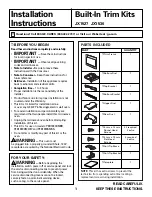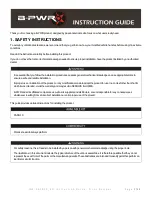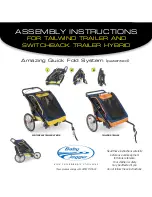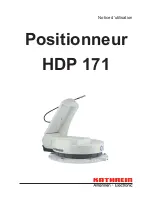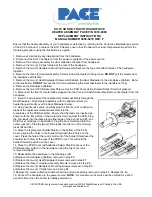
GB
56
Lighting Instructions
Chimney
In order for the stove to perform satisfactorily the chimney height must
be sufficient to ensure an adequate draught of approximately 15 Pa so as
to clear the products of combustion and prevent smoke problems into the
room.
NOTE: A chimney height of not less than 4.5 metres measured vertically
from the outlet of the stove to the top of the chimney should be satisfacto-
ry. Alternatively the calculation procedure given in EN 13384-1 may be used
as the basis for deciding whether a particular chimney design will provide
sufficient draught. BS EN 15287-1:2007 gives additional details.
The outlet from the chimney should be above the roof of the building in ac-
cordance with the provisions of Building Regulations Approved Document J.
If installation is into an existing chimney then it must be sound and have
no cracks or other faults which might allow fumes into the house. Older
properties, especially, may have chimney faults or the cross section may
be too large i.e. more than 230 mm x 230 mm. Remedial action should be
taken, if required, seeking expert advice, if necessary. If it is found neces-
sary to line the chimney then a flue liner suitable for solid fuel must be used
in accordance with Building Regulations Approved Document J.
Any existing chimney must be clear of obstruction and have been swept
clean immediately before installation of the stove. If the stove is fitted in
place of an open fire then the chimney should be swept one month after
installation to clear any soot falls which may have occurred due to the dif-
ference in combustion between the stove and the open fire.
If there is no existing chimney then any new system must be to the designa-
tion described above and in accordance with Building Regulations Approved
Document J.
A single wall metal fluepipe is suitable for connecting the stove to the
chimney but is not suitable for use as the complete chimney. The chimney
and connecting fluepipe must have a minimum diameter of 150 mm and its
dimension should be not less than the size of the outlet socket of the stove.
Any bend in the chimney or connecting fluepipe should not exceed 45°.
90° bends should not be used. Combustible material should not be located
where the heat dissipating through the walls of fireplaces or flues could
ignite it. Therefore when installing the stove in the presence of combustible
materials due account must be taken of the guidance on the separation of
combustible material given in Building Regulations Approved Document J
and also in these stove instructions.
If it is found that there is excessive draught in the chimney then a draught
stabiliser should be fitted. Fitting of a draught stabiliser will affect the
requirement for the permanent air supply into the room in which the stove
is fitted in accordance with Approved Document J (see also combustion air
supply).
Adequate provision e.g. easily accessible soot door or doors must be
provided for sweeping the chimney and connecting fluepipe where it is not
intended for the chimney to be swept through the appliance.
hearth
The hearth should be level and able to accommodate the weight of the stove
and its chimney if the chimney is not independently supported. The weight
of the stove is indicated in the brochure.
The stove should preferably be installed on a non-combustible hearth of a
size and construction that is in accordance with the provisions of the cur-
rent Building Regulations Approved Document J.
The clearance distances to combustible material beneath, surrounding or
upon the hearth and walls adjacent to the hearth should comply with the
guidance on the separation of combustible material given in Building Regu-
lations Approved Document J and also in these stove instructions.
If the stove is to be installed on a combustible floor surface, it must be co-
vered with a non-combustible material at least 12mm thick, in accordance
with Building Regulations Approved Document J, to a distance of 30 cm in
front of the stove and 15 cm to each side measuring from the door of the
combustion chamber.
Combustion air supply
In order for the stove to perform efficiently and safely there must be an
adequate air supply into the room in which the stove is installed to provide
combustion air. The provision of air supply to the stove must be in ac-
cordance with current Building Regulations Approved Document J. Special
attention should be taken in newer build properties where the design air
permeability is less than 5m3/h.m2. Approved Document J gives more infor-
mation on this. An opening window is not appropriate for this purpose.
The fitting of an external air kit direct to outside air must not be con-
sidered substitute for installing the appliance with a permanently open
air vent in compliance with ventilation requirements stated in Approved
Document J. Please reference ADJ for further guidance.
Connection to chimney
Stoves may have a choice of either a rear or top flue gas connector that
allows connection to either a masonry chimney or a prefabricated factory
made insulated metal chimney in accordance with their instructions. In
some cases it may be necessary to fit an adaptor to increase the diameter
of the flue to the minimum required 150 mm section of the chimney or liner.
All joints in the connection between the stove and the chimney must be
made gastight using fire cement and where necessary fire-proof rope infill.
Means should be made for sweeping the entire length of the flue, be that
through the appliance or by suitable sweeping hatch in the flue.
Commissioning and handover
Ensure all parts are fitted in accordance with the instructions.
On completion of the installation allow a suitable period of time for any fire
cement and mortar to dry out, before lighting the stove. Once the stove is
under fire check all seals for soundness and check that the flue is functio-
ning correctly and that all products of combustion are vented safely to
atmosphere via the chimney terminal.
On completion of the installation and commissioning ensure that the opera-
ting instructions for the stove are left with the customer. Ensure to advise
the customer on the correct use of the appliance and warn them to use only
the recommended fuel for the stove.
Advise the user what to do should smoke or fumes be emitted from the
stove. The customer should be warned to use a fireguard to BS 8423:2002
(Replaces BS 6539) in the presence of children, aged and/or infirm persons.
Содержание C i50
Страница 1: ...Ci50 Ci51 www contura eu Operation instructions...
Страница 13: ......
Страница 14: ......
Страница 15: ......


















